A Novel Methodology for Evaluating the Impact of Energy Efficiency Measures on the Cabin Thermal Comfort of Electric Vehicles
Abstract
1. Introduction
1.1. Background and Problem
1.2. Previous Research on the Topic
1.3. Boundaries of the Current Research Problem
2. Methodology
2.1. Overall Methodology
2.2. Case Study
2.3. Thermal Comfort Modelling
- M metabolic heat rate (W/m2);
- W activity level (W/m2) removed from the inputs of Figure 4 as assumed negligible;
- tcl temperature at clothes’ level (K);
- pa water vapour pressure (Pa);
- ta air temperature (K);
- Icl thermal insulation of clothes (Clo);
- fcl clothing factor (-);
- tmr mean radiant temperature (K);
- hc convective heat transfer (W/m2.K).
2.4. Cabin CFD Modelling
2.5. HVAC System Modelling
2.6. Thermal and Comfort Model and HVAC System Integration
v = f (table(i), Vin, Tin), at location j
3. Results
3.1. Models Validation
3.1.1. CFD and 1D Thermal Model
3.1.2. One-Dimensional Comfort Model
3.2. Parametric Variations on the Case Study
4. Discussion and Conclusions
Author Contributions
Funding
Conflicts of Interest
References
- European Commission. Regulation (EC) No 443/2009 of the European Parliament and of the Council; European Commission: Brussels, Belgium, 2009. [Google Scholar]
- Athanasopoulou, L.; Bikas, H.; Stavropoulos, P. Comparative Well-to-Wheel Emissions Assessment of Internal Combustion Engine and Battery Electric Vehicles. Procedia CIRP 2018, 78, 25–30. [Google Scholar] [CrossRef]
- Shete, K. Influence of Automotive Air Conditioning load on Fuel Economy of IC Engine Vehicles. Int. J. Sci. Eng. Res. 2015, 6, 1367–1372. [Google Scholar]
- Farrington, R.; Rugh, J. Impact of Vehicle Air Conditioning on Fuel Economy, Tailpipe Emissions, and Electric Vehicle Range. In Proceedings of the Earth Technologies Forum, Washington, DC, USA, 31 October 2000. [Google Scholar]
- Li, C.; Brewer, E.; Pham, L.; Jung, H. Reducing Mobile Air Conditioner (MAC) Power Consumption Using Active Cabin-Air-Recirculation in A Plug-In Hybrid Electric Vehicle (PHEV). World Electr. Veh. J. 2018, 9, 51. [Google Scholar] [CrossRef]
- Shibata, S.; Nakagawa, T. Mathematical Model of Electric Vehicle Power Consumption for Traveling and Air-Conditioning. J. Energy Power Eng. 2015, 9, 269–275. [Google Scholar] [CrossRef][Green Version]
- Adriano, S.; Chiara, F.; Fabrizio, Z.; Alessandro, D.; Fabio, O.; Annalisa, D. Experimental Analysis of the Auxiliaries Consumption in the Energy Balance of a Pre-Series Plug-In Hybrid-Electric Vehicle. Energy Procedia 2014, 45, 779–788. [Google Scholar] [CrossRef]
- Van Vliet, O.; Brouwer, A.S.; Kuramochi, T.; van Den Broek, M.; Faaij, A. Energy use, cost and CO2 emissions of electric cars. J. Power Sources 2011, 196, 2298–2310. [Google Scholar] [CrossRef]
- Evtimov, I.; Ivanov, R.; Sapundjiev, M. Energy consumption of auxiliary systems of electric cars. MATEC Web Conf. 2017, 133, 06002. [Google Scholar] [CrossRef]
- Iora, P.; Tribioli, L. Effect of Ambient Temperature on Electric Vehicles’ Energy Consumption and Range: Model Definition and Sensitivity Analysis Based on Nissan Leaf Data. World Electr. Veh. J. 2019, 10, 2. [Google Scholar] [CrossRef]
- Kapeller, H.; Dvorak, D.; Simic, D. Improvement potentials for user-centrically designed electric vehicles: The QUIET Project. In Proceedings of the 8th Transport Research Arena TRA 2020, Helsinki, Finland, 27–30 April 2020. [Google Scholar]
- Doyle, A.; Muneer, T. Energy consumption and modelling of the climate control system in the electric vehicle. Energy Explor. Exploit. 2019, 37, 519–543. [Google Scholar] [CrossRef]
- Gellai, I.; Basciotti, D.; Simic, D. 1D thermal model and measurements to estimate HVAC-modules energy consumption of an electric truck cabin. In Proceedings of the SAE Thermal Management Systems Symposium, Plymouth, MI, USA, 15–17 October 2019. [Google Scholar]
- Kambly, K.R.; Bradley, T.H. Estimating the HVAC energy consumption of plug-in electric vehicles. J. Power Sources 2014, 259, 117–124. [Google Scholar] [CrossRef]
- Zhang, Z.; Li, W.; Zhang, C.; Chen, J. Climate control loads prediction of electric vehicles. Appl. Therm. Eng. 2017, 110, 1183–1188. [Google Scholar] [CrossRef]
- Al Faruque, M.A.; Vatanparvar, K. Modeling, analysis, and optimization of Electric Vehicle HVAC systems. In Proceedings of the 21st Asia and South Pacific Design Automation Conference (ASP-DAC), Macau, China, 25–28 January 2016. [Google Scholar]
- Mebarki, B.; Draoui, B.; Allaou, B.; Rahmani, L.; Benachour, E. Impact of the Air-Conditioning System on the Power Consumption of an Electric Vehicle Powered by Lithium-Ion Battery. Model. Simul. Eng. 2013, 2013, 935784. [Google Scholar] [CrossRef]
- Hendricks, T.J. Vehicle Transient Air Conditioning Analysis: Model Development & System Optimization Investigations; National Renewable Energy Lab. (NREL): Golden, CO, USA, 2001.
- Lee, H.; Hwang, Y.; Song, I.; Jang, K. Transient thermal model of passenger car’s cabin and implementation to saturation cycle with alternative working fluids. Energy 2015, 90, 1859–1868. [Google Scholar] [CrossRef]
- Elsevier. Available online: https://www.sciencedirect.com/ (accessed on 3 February 2020).
- Danca, P.; Vartires, A.; Dogeanu, A. An overview of current methods for thermal comfort assessment in vehicle cabin. In Proceedings of the Sustainable Solutions for Energy and Environment, EENVIRO—YRC 2015, Bucharest, Romania, 18–20 November 2015. [Google Scholar]
- Croitoru, C.; Nastase, I.; Bode, F.; Meslem, A.; Dogeanu, A. Thermal comfort models for indoor spaces and vehicles—Current capabilities and future perspectives. Renew. Sustain. Energy Rev. 2015, 44, 304–318. [Google Scholar] [CrossRef]
- Simion, M.; Socaciu, L.; Unguresan, P. Factors which influence the thermal comfort inside of vehicles. Energy Procedia 2016, 85, 472–480. [Google Scholar] [CrossRef]
- Moon, J.H.; Lee, J.W.; Jeong, C.H.; Lee, S.H. Thermal comfort analysis in a passenger compartment considering the solar radiation effect. Int. J. Therm. Sci. 2016, 107, 77–88. [Google Scholar] [CrossRef]
- Qia, C.; Heliana, Y.; Liua, J.; Zhang, L. Experiment Study on the Thermal Comfort inside a Car Passenger Compartment. Procedia Eng. 2017, 205, 3607–3614. [Google Scholar] [CrossRef]
- Mao, Y.; Wang, J.; Li, J. Experimental and numerical study of air flow and temperature variations in an electric vehicle cabin during cooling and heating. Appl. Therm. Eng. 2018, 137, 356–367. [Google Scholar] [CrossRef]
- Zhou, X.; Lai, D.; Chen, Q. Experimental investigation of thermal comfort in a passenger car under driving conditions. Build. Environ. 2019, 149, 109–119. [Google Scholar] [CrossRef]
- Kong, M.; Dang, T.Q.; Zhang, J.; Khalifa, H.E. Micro-environmental control for efficient local heating: CFD simulation and manikin test verification. Build. Environ. 2019, 147, 382–396. [Google Scholar] [CrossRef]
- Alahmer, A.; Abdelhamid, M.; Omar, M. Design for thermal sensation and comfort states in vehicles cabins. Appl. Therm. Eng. 2012, 36, 126–140. [Google Scholar] [CrossRef]
- Changa, T.-B.; Sheub, J.-J.; Huangb, J.-W.; Lina, Y.-S.; Chang, C.-C. Development of a CFD model for simulating vehicle cabin indoor air quality. Transp. Res. Part D 2018, 62, 433–440. [Google Scholar] [CrossRef]
- Oha, J.; Choia, K.; Sona, G.; Parka, Y.-J.; Kangd, Y.-S.; Kim, Y.-J. Flow analysis inside tractor cabin for determining air conditioner vent lacation. Comput. Electron. Agric. 2020, 169, 105199. [Google Scholar] [CrossRef]
- Danca, P.; Bode, F.; Nastase, I.; Meslem, A. On the possibility of CFD modeling of the indoor environment in a vehicle. Energy Procedia 2017, 112, 656–663. [Google Scholar] [CrossRef]
- Chen, K.; Kaushik, S.; Han, T.; Ghosh, D.; Wang, M. Thermal Comfort Prediction and Validation in a Realistic Vehicle Thermal Environment. In Proceedings of the SAE 2012 World Congress & Exhibition, Detroit, MI, USA, 24–26 April 2012. [Google Scholar]
- Warey, A.; Kaushik, S.; Khalighi, B.; Cruse, M.; Venkatesan, G. Data-driven prediction of vehicle cabin thermal comfort: Using machine learning and high-fidelity simulation results. Int. J. Heat Mass Transf. 2020, 148, 119083. [Google Scholar] [CrossRef]
- Oi, H.; Tabata, K.; Naka, Y.; Takeda, A.; Tvochihara, Y. Effects of heated seats in vehicles on thermal comfort during the initial warm-up period. Appl. Ergon. 2012, 43, 360–367. [Google Scholar] [CrossRef]
- Oh, M.S.; Ahn, J.H.; Kim, D.W.; Jang, D.S.; Kim, Y. Thermal comfort and energy saving in a vehicle compartment using a localized air-conditioning system. Appl. Energy 2014, 133, 14–21. [Google Scholar] [CrossRef]
- QUIET Project. Available online: http://www.quiet-project.eu/ (accessed on 3 April 2020).
- Dymola. Available online: https://www.3ds.com/products-services/catia/products/dymola (accessed on 3 April 2020).
- Modelica Standard Library. Available online: https://www.modelica.org/libraries (accessed on 3 April 2020).
- American Society of Heating, Refrigerating and Air-Conditioning Engineers (ASHRAE). Chapter 8 Thermal Comfort. In ASHRAE Handbook Fundamentals; ASHRAE: Atlanta, GA, USA, 1997; pp. 8.1–8.26. [Google Scholar]
- Ansys SpaceClaim 3D Modeling. Available online: http://www.spaceclaim.com/en/default.aspx (accessed on 10 January 2020).
- Ansys Fluent. Available online: https://www.ansys.com/products/fluids/ansys-fluent (accessed on 10 January 2020).
- ANSYS. ANSYS Fluent Theory Guide; ANSYS Inc.: Canonsburg, PA, USA, 2013. [Google Scholar]
- SnappyHexMesh. Available online: http://www.wolfdynamics.com/wiki/meshing_OF_SHM.pdf (accessed on 10 January 2020).
- TIL Suite. Available online: https://www.tlk-thermo.com/index.php/en/software/til-suite (accessed on 3 April 2020).

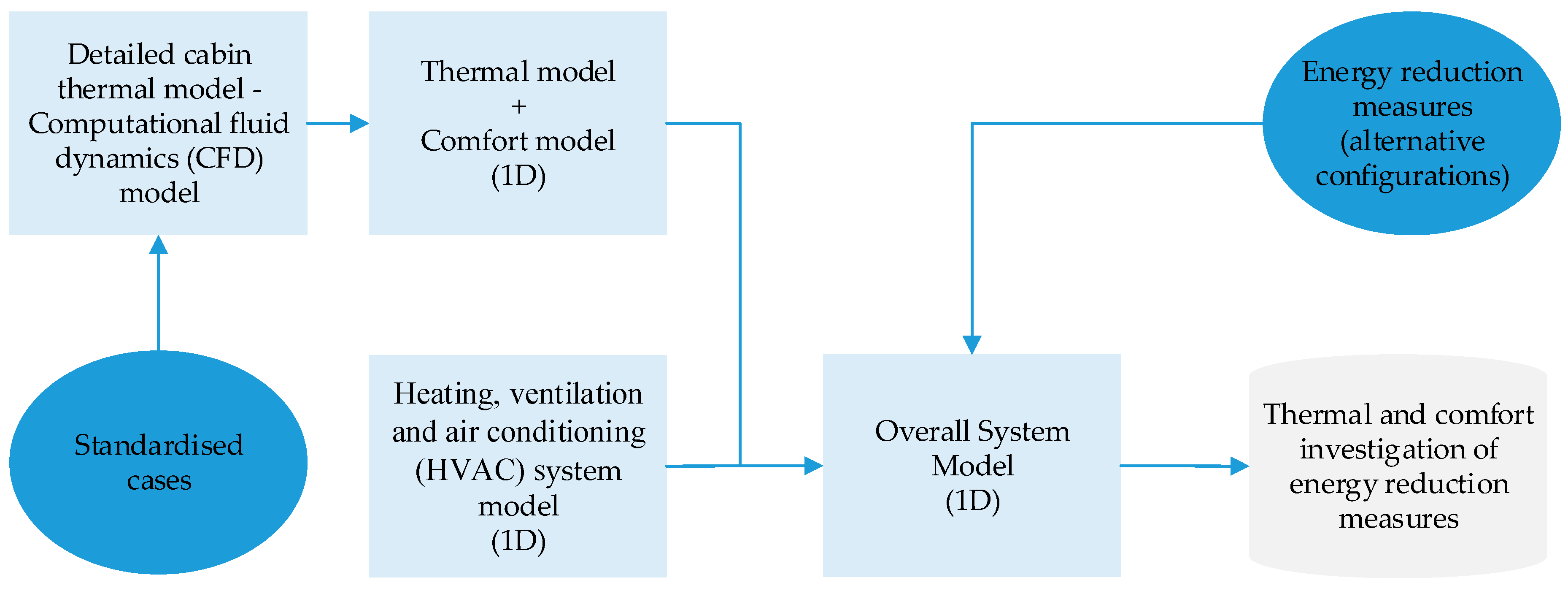
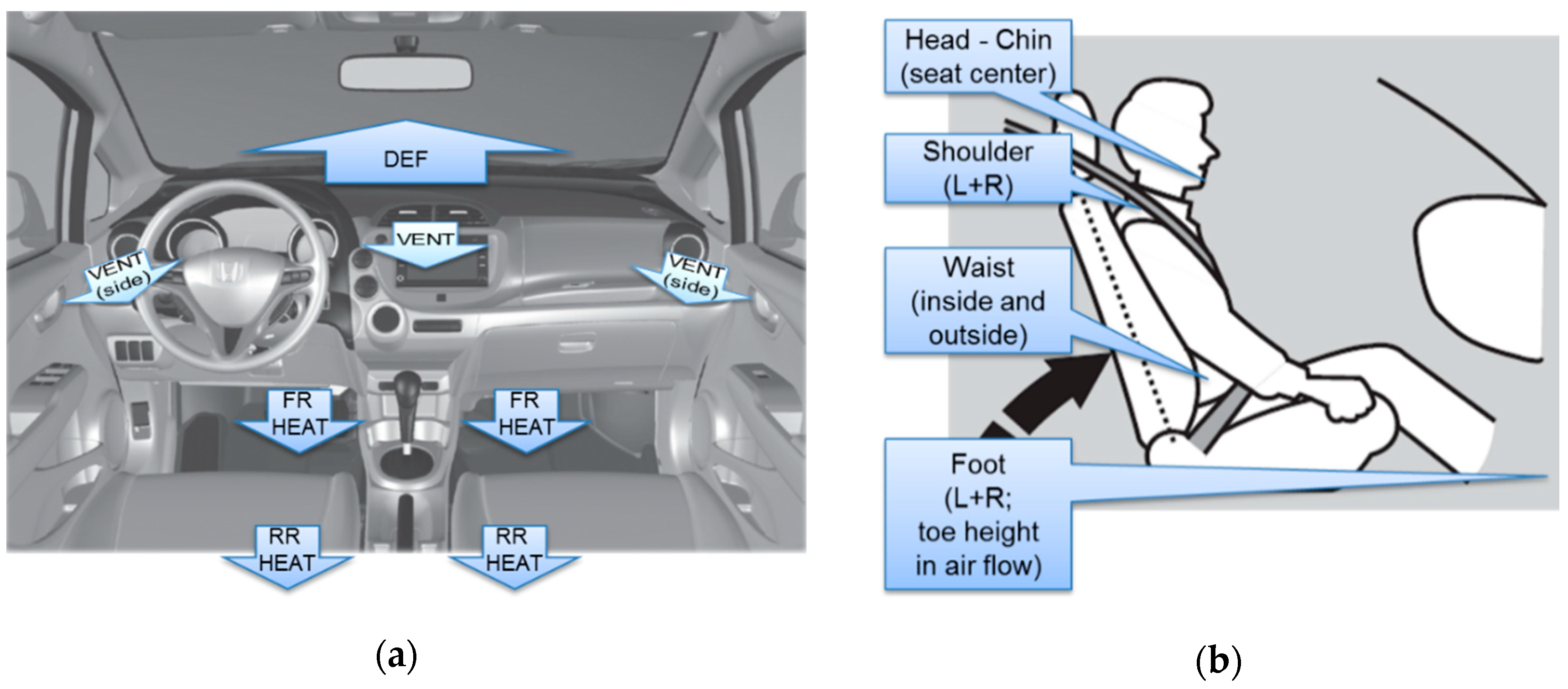
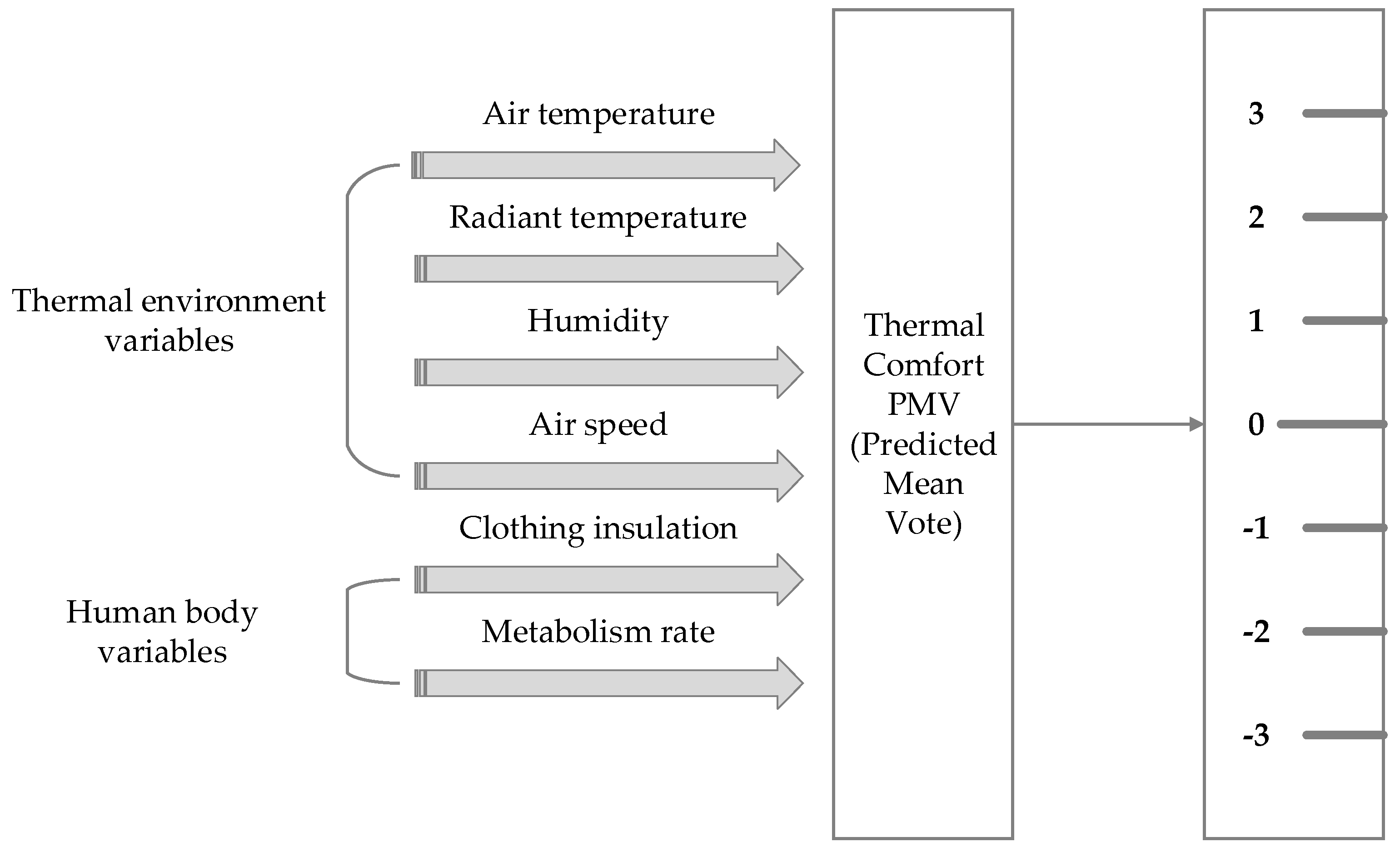


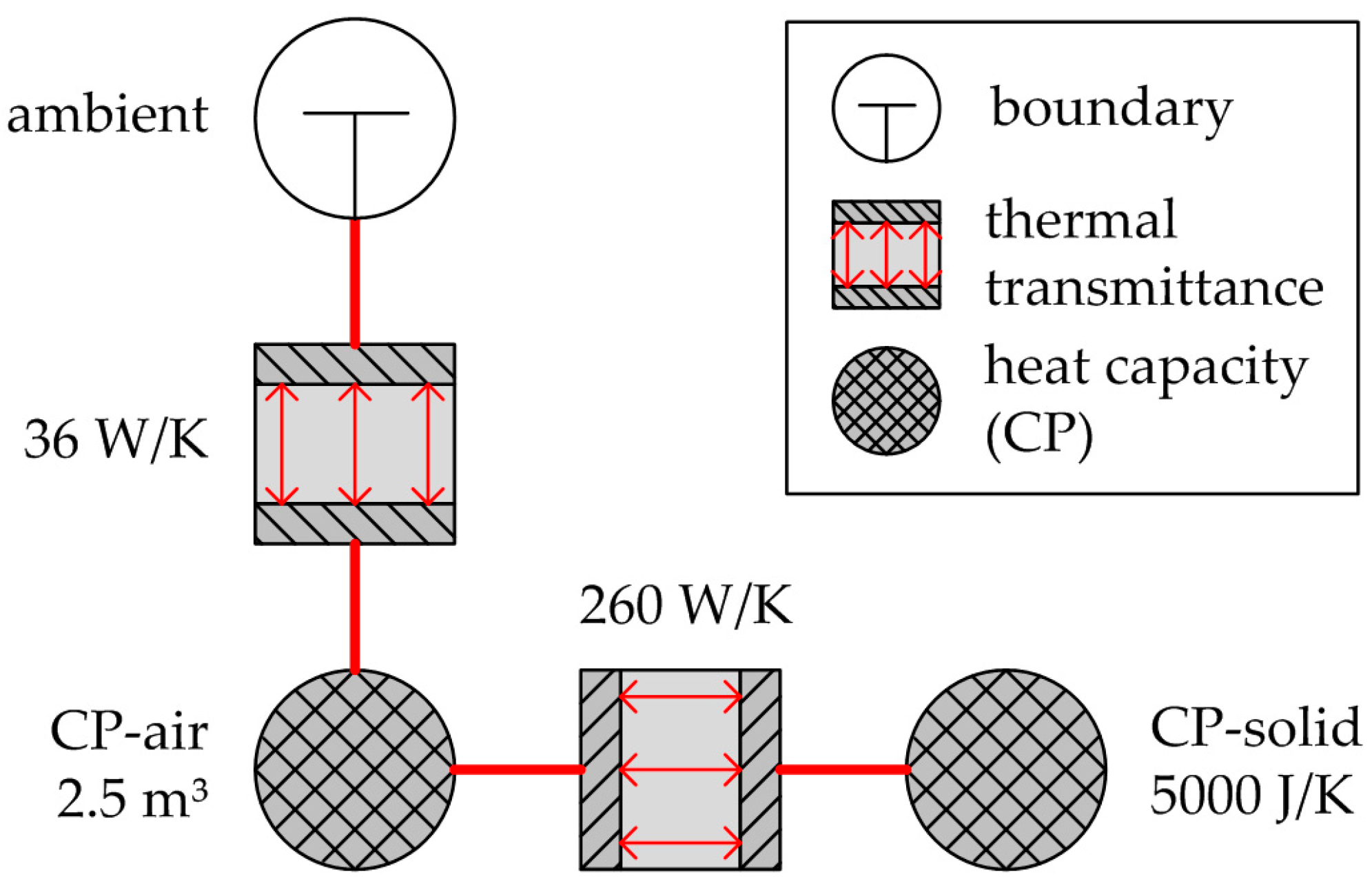
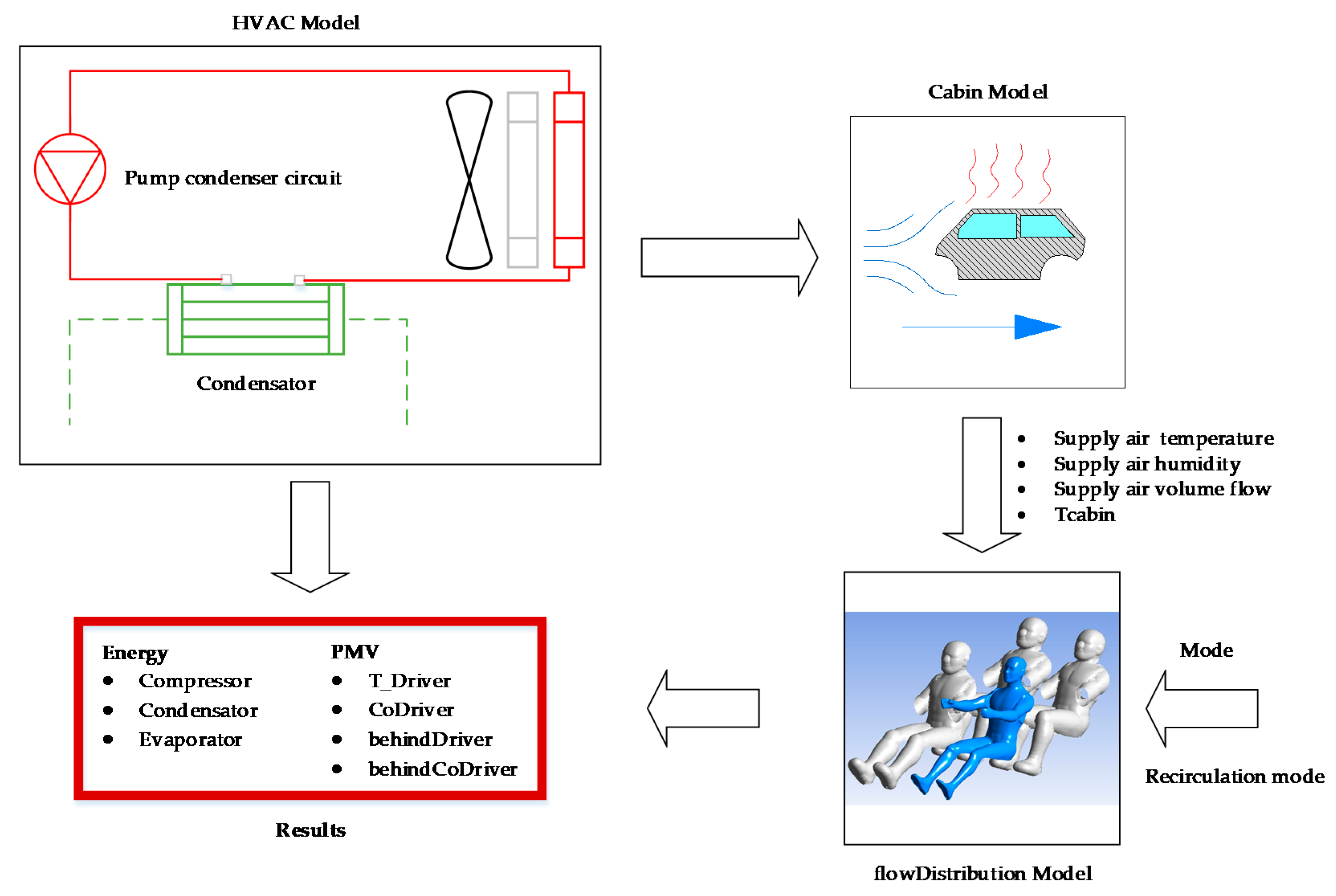
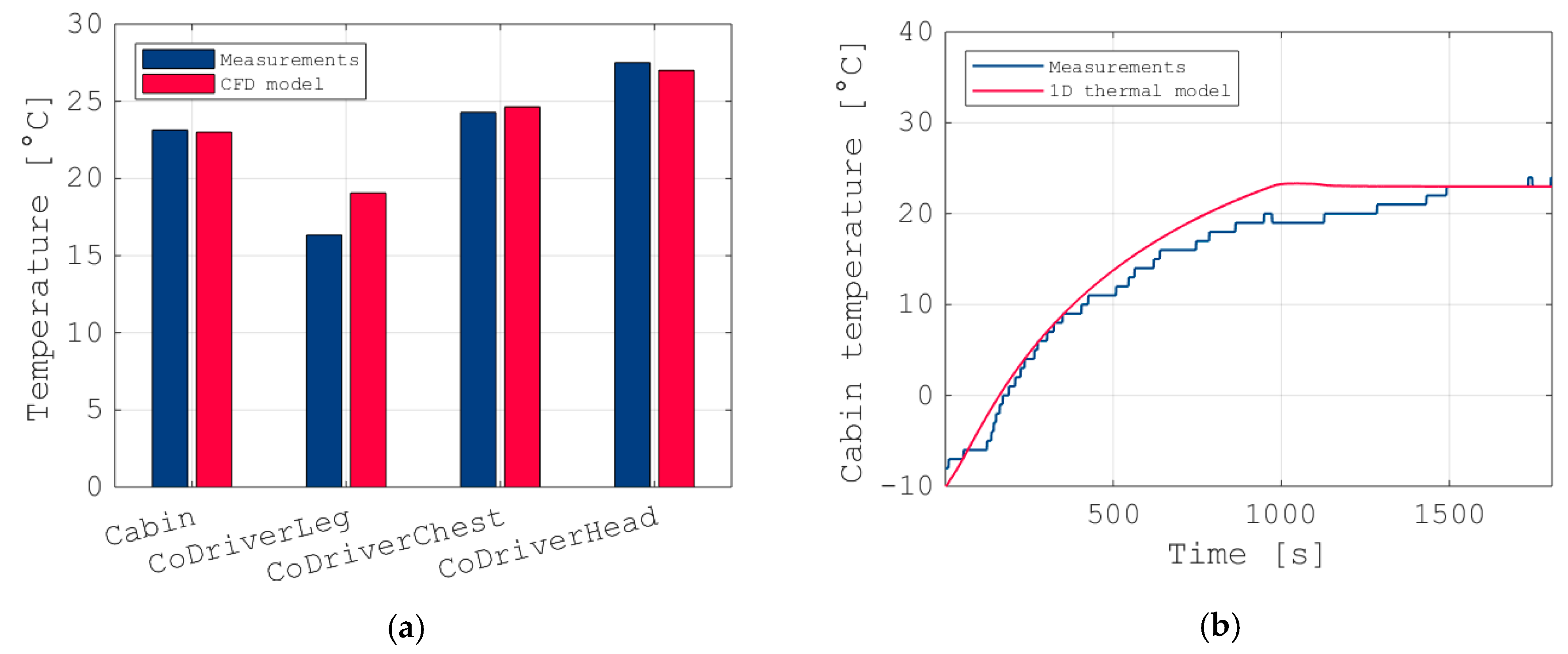
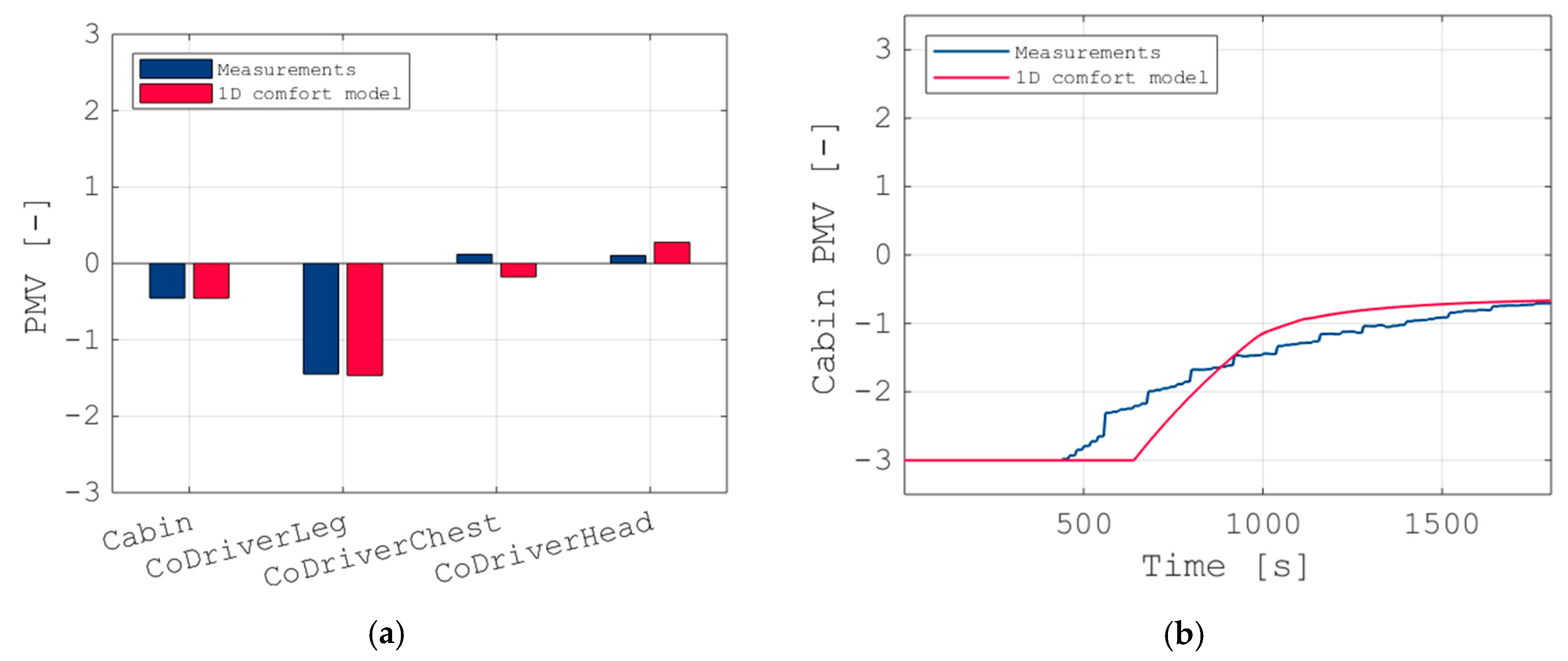
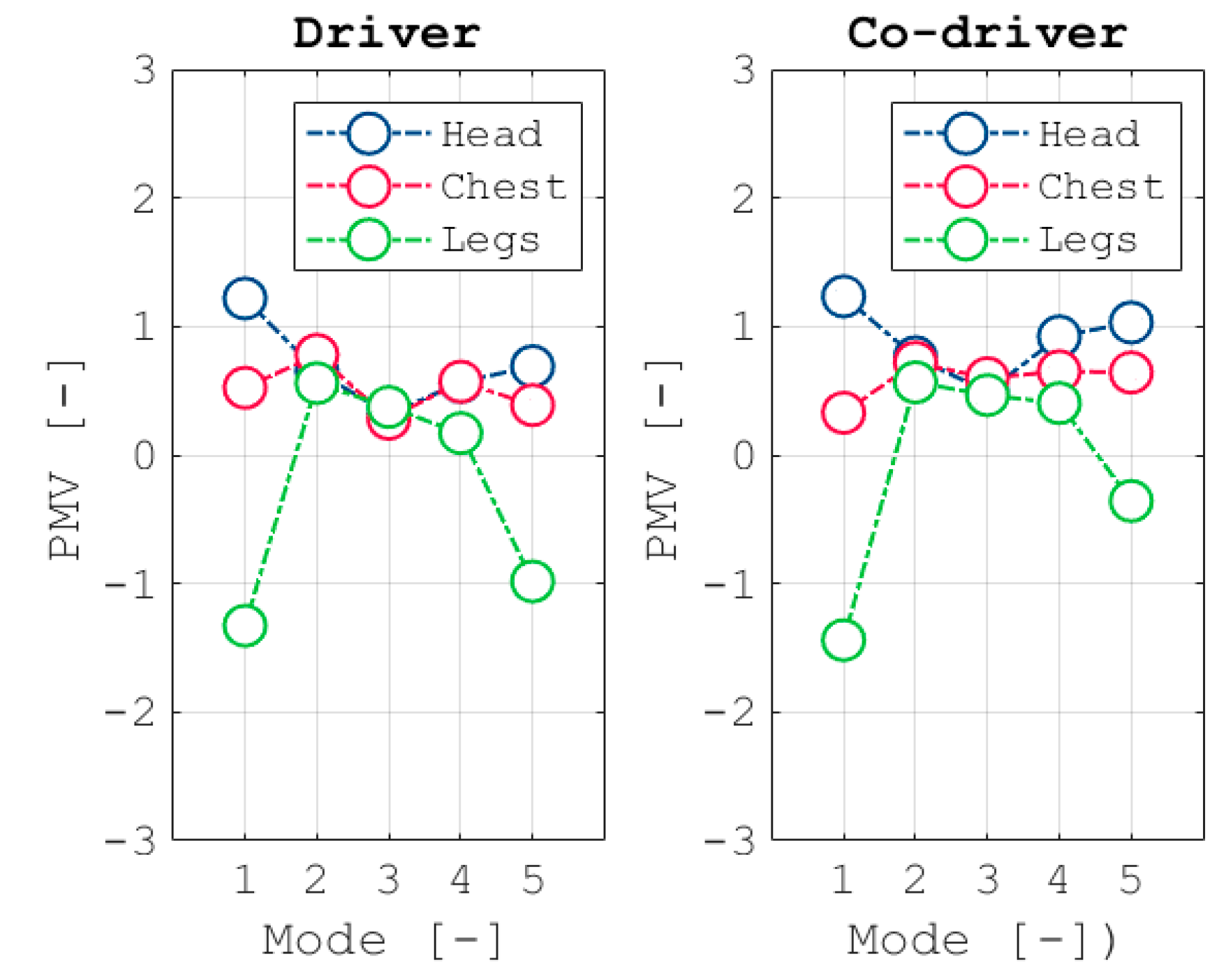
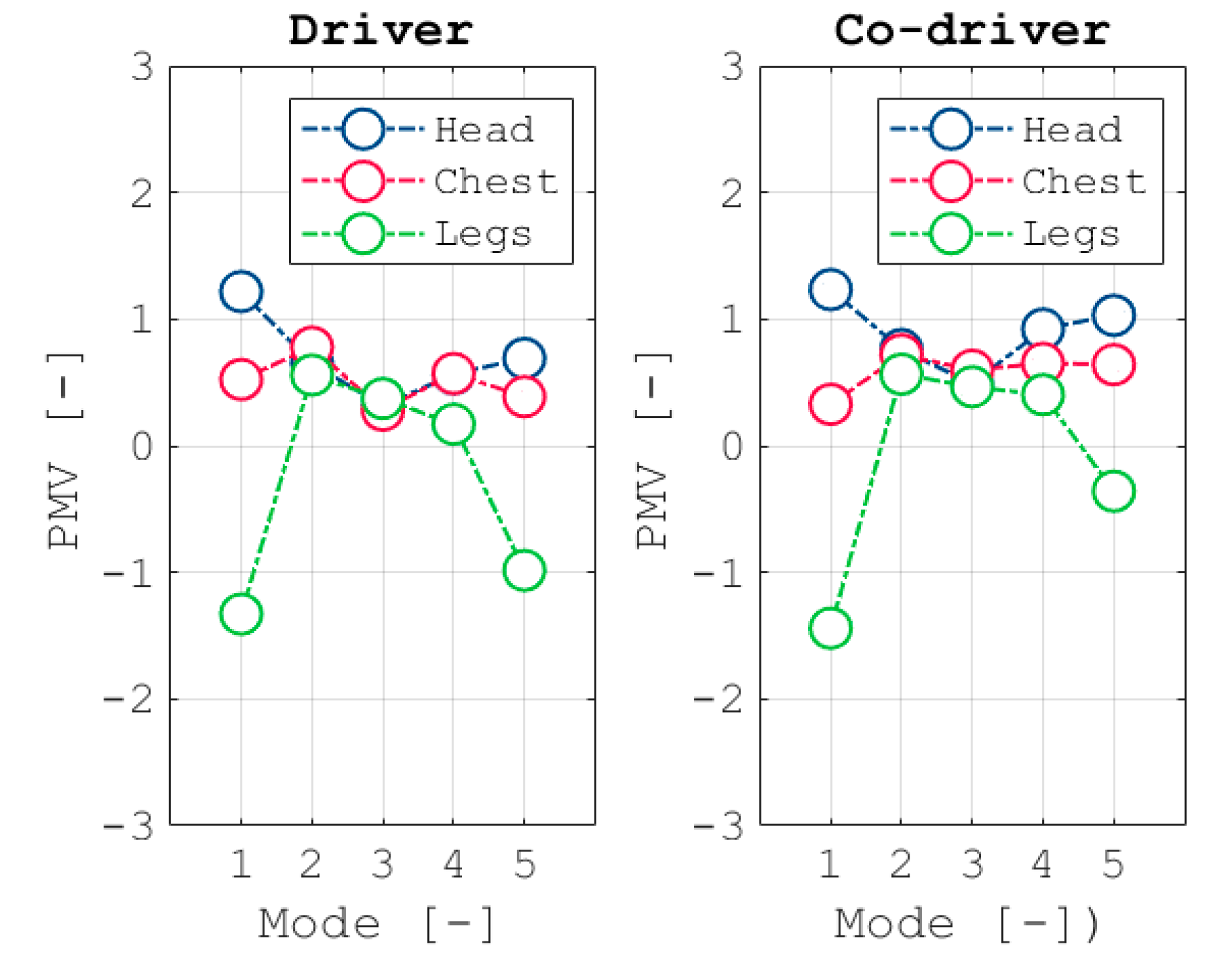
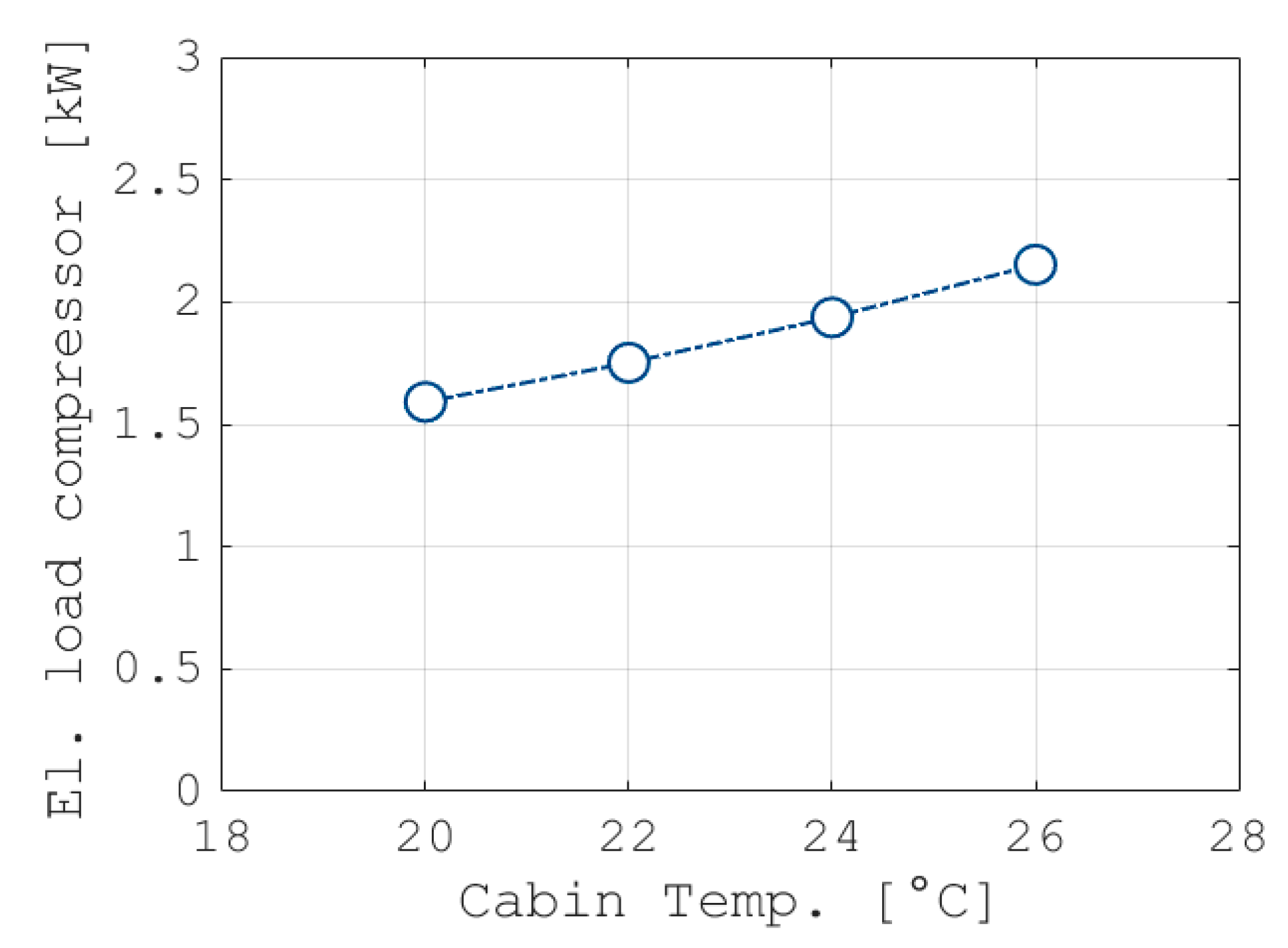
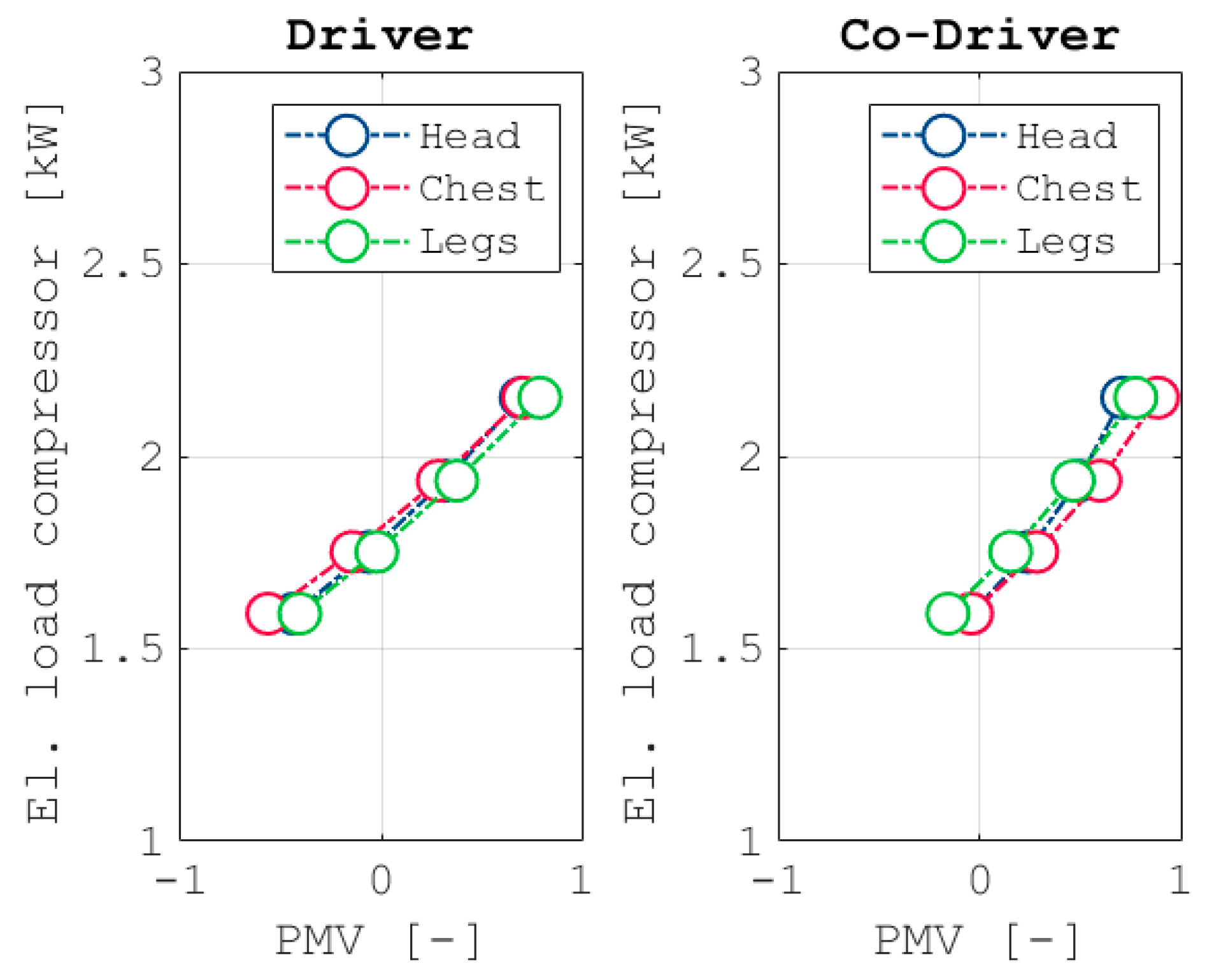
| Standardised Cases | ||
|---|---|---|
| Ambient temperature | Winter: −10 °C, Summer: +40 °C | |
| Ambient humidity | ~0% | |
| Radiation | ~0 W/m2 | |
| HVAC settings | Recirculation | FRESH |
| Mode | VENT, BI-LEV, HEAT, HEAT-DEF | |
| Fan | 50, 200, 400 m3/h | |
| Target outlet temperature | Winter: 45 °C, Summer: 5 °C |
| Mode | VENT (side) | VENT | HEAT | DEF |
|---|---|---|---|---|
| (1) VENT | Open | each 25% | 0% | 0% |
| (2) BI-LEV | Open | 50% | 50% | 0% |
| (3) HEAT | Open | 15% | 75% | 10% |
| (4) HEAT-DEF | Open | 20% | 45% | 35% |
| (5) DEF | Open | 32% | 0% | 6% |
| Validation Case | ||
|---|---|---|
| Ambient temperature | Winter: −10 °C | |
| Ambient humidity | ~0% | |
| Radiation | ~0 W/m2 | |
| HVAC settings | Recirculation | FRESH |
| Mode | DEF | |
| Fan | 150 m3/h | |
| Target outlet temperature | DEF 60 °C, VENT 55 °C |
| −3 | −2 | −1 | 0 | +1 | +2 | 3 |
|---|---|---|---|---|---|---|
| cold | cool | slightly cool | thermal neutral state | slightly warm | warm | hot |
| Variable | Typical Ranges | Case Study |
|---|---|---|
| M | 46 to 232 W/m2 (0.8 to 4 met) | 70 W/m2 (1.2 met) |
| Icl | 0 to 0.310 m2.K/W (0 to 2 clo) | 0.186 m2.K/W (1.2 clo) |
| Tair | 10 to 30 °C | 23 °C |
| Trad | 10 to 40 °C | equal to air temperature |
| vair | 0 to 1 m/s | values from simulation |
| RH | 20–80% | <5% |
| Reference | Material | Density | Specific Heat | Thermal Conductivity | |
|---|---|---|---|---|---|
| (-) | (kg/m3) | (J/kg.K) | (W/m.K) | ||
| Windshield | [42] | Glass | 2530 | 754 | 1.17 |
| Wall | Assumptions | Fictive material | 996 | 1480 | 2.70 |
| Manikin | Assumptions | Skin | 1000 | 3500 | 0.21 |
| Variable | Value |
|---|---|
| Mode (5) | VENT, BI-LEV, HEAT, HEAT-DEF, DEF |
| Recirculation mode (2) | on, off |
| Cabin supply temperature (2) | 10 °C, 45 °C |
| Cabin supply volume flow rate (4) | 0, 50, 200, 400 m3/h |
© 2020 by the authors. Licensee MDPI, Basel, Switzerland. This article is an open access article distributed under the terms and conditions of the Creative Commons Attribution (CC BY) license (http://creativecommons.org/licenses/by/4.0/).
Share and Cite
Basciotti, D.; Dvorak, D.; Gellai, I. A Novel Methodology for Evaluating the Impact of Energy Efficiency Measures on the Cabin Thermal Comfort of Electric Vehicles. Energies 2020, 13, 3872. https://doi.org/10.3390/en13153872
Basciotti D, Dvorak D, Gellai I. A Novel Methodology for Evaluating the Impact of Energy Efficiency Measures on the Cabin Thermal Comfort of Electric Vehicles. Energies. 2020; 13(15):3872. https://doi.org/10.3390/en13153872
Chicago/Turabian StyleBasciotti, Daniele, Dominik Dvorak, and Imre Gellai. 2020. "A Novel Methodology for Evaluating the Impact of Energy Efficiency Measures on the Cabin Thermal Comfort of Electric Vehicles" Energies 13, no. 15: 3872. https://doi.org/10.3390/en13153872
APA StyleBasciotti, D., Dvorak, D., & Gellai, I. (2020). A Novel Methodology for Evaluating the Impact of Energy Efficiency Measures on the Cabin Thermal Comfort of Electric Vehicles. Energies, 13(15), 3872. https://doi.org/10.3390/en13153872







